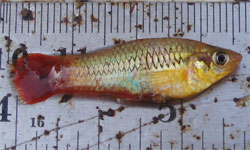Platyfish
Introduction
 The platy or southern or variable platyfish (Xiphophorus maculatus or X. variatus or sometimes a hybrid between these two species) are a small non-native species kept as a tropical aquarium fish commonly sold from pet shops and aquarists. Platyfish are a tough species and are considered a potential pest in countries where they have been introduced. Most pests are extremely difficult if not impossible to eradicate once established. Pest fish compete with native fish for food and space and many are able to survive in habitats that native fish cannot.
The platy or southern or variable platyfish (Xiphophorus maculatus or X. variatus or sometimes a hybrid between these two species) are a small non-native species kept as a tropical aquarium fish commonly sold from pet shops and aquarists. Platyfish are a tough species and are considered a potential pest in countries where they have been introduced. Most pests are extremely difficult if not impossible to eradicate once established. Pest fish compete with native fish for food and space and many are able to survive in habitats that native fish cannot.
In February, 2008 platyfish (confirmed by the Australian Museum to be the variable platyfish, Xiphophous variatus) were discovered in the wild for the first time in NSW at Medowie near Newcastle. NSW DPIRD fisheries technicians discovered the platyfish during a fish survey in the Campvale drain, an artificial drainage channel which leads into Grahamstown Dam (part of the Williams River catchment), the Hunter region’s main water supply.
Natural distribution and biology
Platyfish are native to Mexico and Central America and are closely related to Gambusia holbrooki (eastern gambusia) and swordtails. Platyfish prefer to inhabit shallow slow moving streams and drainages, and stagnant waters such as ditches and pools, in particular where there is vegetation such as tree canopies and weedy banks. Platyfish prefer substrates such as mud, gravel, or silt.
Platyfish are a non-migratory tropical freshwater fish preferring water temperatures between 18 - 25oC and a pH of 7 – 8. However, they have been shown to tolerate temperature extremes from 10 - 40oC and dissolved oxygen levels down to 3ppm. They feed on worms, crustaceans, insects and plant matter. Platyfish give birth to live young, typically become sexually mature from 4 months and can attain a maximum size of about 7 cm. If the conditions are suitable platyfish can rapidly establish in large numbers.
Where are they in NSW?
In February 2008, platyfish were recorded for the first time in NSW from a section of Medowie’s Campvale drain. Campvale drain is an artificial drain and is approximately 9km long. There are numerous smaller and secondary drains, suburban ponds and other flood catchment features in the Medowie area that form a drainage network which connects to Campvale drain. This drainage channel leads into Grahamstown Dam (part of the Williams River catchment), Newcastle’s main water supply.
Platyfish have also been found in creeks around Brisbane and in far North Queensland.
How did they get here?
It is not known how platyfish were introduced into the drain however the most likely vectors are either deliberate release from an aquarium or escape from a backyard pond during flood events. Numbers originally reported were low, however this may change as the platyfish have a high rate of reproduction and if conditions are suitable they can rapidly establish in large numbers.
It is illegal to release fish into the wild without a stocking permit and heavy penalties apply. The release of small aquarium fish can cause significant damage to our native fish and other wildlife. NSW DPIRD recommends unwanted fish are given to a friend or pet shop. If an appropriate home cannot be found see the recommended guidelines for humane destruction of fish.
What is NSW DPIRD doing?
NSW DPIRD attempted to eradicate the platyfish in Campvale drain, Medowie in January 2009. Follow up surveys were conducted in March 2009 and July 2009. Unfortunately, the follow up surveys confirmed that platyfish are still present in the drain. For more information, please read the following report:
The confirmation that platyfish are still present in the Campvale drain and the likelihood of them reoccurring (via release from a home aquarium, flooding resulting in release from outdoor ponds, or the eradication attempt being unsuccessful) means eradication of platyfish from Campvale drain is no longer considered viable.
What are the impacts?
Little information is available on the impacts that platyfish have on native aquatic communities in its introduced range. However, platyfish are considered a highly resilient species with the potential to become a pest, and most pests are extremely difficult if not impossible to eradicate once established.
What you can do to help
- Aquarium fish belong only at home in a fish tank!
- Give unwanted aquarium fish to friends or a pet shop, rather than letting them go in the wild (Note: it is illegal to release live fish into NSW waterways without a permit, and heavy penalties apply).
- Design backyard fishponds carefully to prevent fish washing out during heavy rains – for example, by using fine screens on overflow areas. Wherever possible, stock ponds with native species endemic to your local area.
- Be on the lookout for new species in your local waterways.
- If you find any fish that you think might be a platyfish or another species not native to the area, take a photo, freeze the fish whole and Report it!
- In some areas, local community groups form to help in the fight against unwanted pest fish – Be involved!
References and further reading
- Washington University School of Medicine, Department of Genetics, Genome Sequence Centre, Xiphophorus maculatus 2008. Available from http://genome.wustl.edu/genomes/view/xiphophorus_maculatus (Accessed May 2010)
- Rotenone treatment of Campvale drain, Medowie to eradicate platyfish, Xiphophorus variatus; a post-eradication report, July 2009